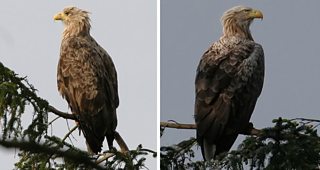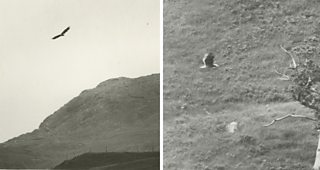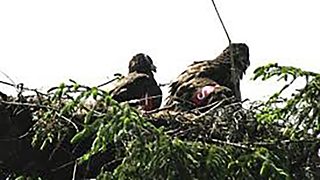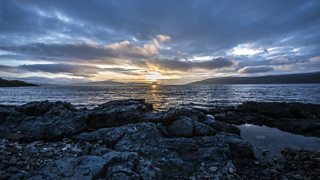By Dave Sexton, RSPB Scotland Mull Officer
It’s hard to express just how much these two sea eagles mean to me. My connections to them – and to Frisa in particular – go way back and have had an incalculable impact on my RSPB career and personal life.

White-tailed eagles Frisa (left) and Skye (right) have produced numerous chicks during their many years together on Mull. Credit: Iain Erskine
Where it all began
For Spring, Autumn and Winterwatch fans, the adventures of Skye and Frisa are deeply embedded in ‘Watches’ history. Whilst there were earlier incarnations, the ‘Watches’ as we know them today began on �������� Two on Monday 30 May 2005. On that first ever programme, Skye and Frisa and their two chicks, Itchy and Scratchy, were beamed live from Mull into the nation’s living rooms. It had been a tense build up to the live shows and I was a nervous wreck by the end of that historic first week. As the Outside Broadcast, satellite and catering trucks rolled onto the ferry and off to the next live location, I had time to reflect on this very special pair of sea eagles and now TV wildlife celebrities in their own right.
Vital legacy
Let’s go back a few years. Frisa was hatched on Mull in 1992. Her mother was the legendary pioneering female ‘Blondie’ who had successfully raised the first UK sea eagle chick to fledge in 1985. With RSPB colleagues, I had watched over and protected Blondie, her mate and family that year as they made history. She became an integral part of my life and I followed her progress raising many more chicks, including Frisa, in the following years. She died in 2000 but her vital legacy lives on.
When I see Frisa now I guess I’m remembering her mum a lot of the time and all the people and friends I spent time with, some sadly now passed, in those momentous days. She even looks like her mum. But then again, I know, don’t they all?

Blondie, the white-tailed eagle, soars over the Isle of Mull in the mid 1980s. Credit: Chris Gomersall, RSPB Images
A special couple
Frisa and Skye paired up in 1997 and had their first chick in 1998 (she too still nests on Mull). Since then, they have raised chicks, often two a year, at a variety of locations but usually never far from their Loch Frisa home. I’ve been so lucky to work with landowners, farmers and the great team from Forestry and Land Scotland since I returned here as RSPB Mull Officer in 2003. They have provided a home for Skye and Frisa over all these years and have frequently adapted their forest management around them to keep them safe.
How do we know it’s them?
Here’s the hard truth. Hand on heart, when I see the two adult sea eagles at Loch Frisa now, am I really 100% certain it’s still them? We know adults get replaced by incoming birds. Sometimes it’s obvious (a sub-adult, a fight, a failed nest) but sometimes it isn’t. Two Mull territories had males replaced in 2021. Frisa lost her ‘Green L’ wing tags a while back but she has a BTO ring on her right leg and Skye, unusually, was ringed on his left leg in 1994. I’ve never seen any hint of a change of adult in their territory and in my heart I feel it is still my old friends. Frisa will be 30 this year, Skye 28. That’s quite old for wild sea eagles. Their time with us is sadly running out.

This pair of chicks, Itchy and Scratchy, won the hearts of Watches fans during the first broadcast of Springwatch back in 2005. Credit: Ian Erskine
For this Winterwatch, cameraman Jim Manthorpe has been filming a pair of adult sea eagles in an area which was once part of Skye and Frisa’s home range. She is ringed on her right leg; he is ringed on his left leg. So far so good. Jim will now try to zoom in on the rings to see if we can read them. Then we will know. If it’s not them we can still celebrate the majesty of this remarkable bird and the wonderful conservation success story they represent. If it is them, I might just shed a quiet, happy tear and thank them for, well, pretty much everything.

The spectacular landscape of Mull makes it a special place for lots of wildlife, in particular, white-tailed and golden eagles. Credit – Ben Andrew, RSPB Images
